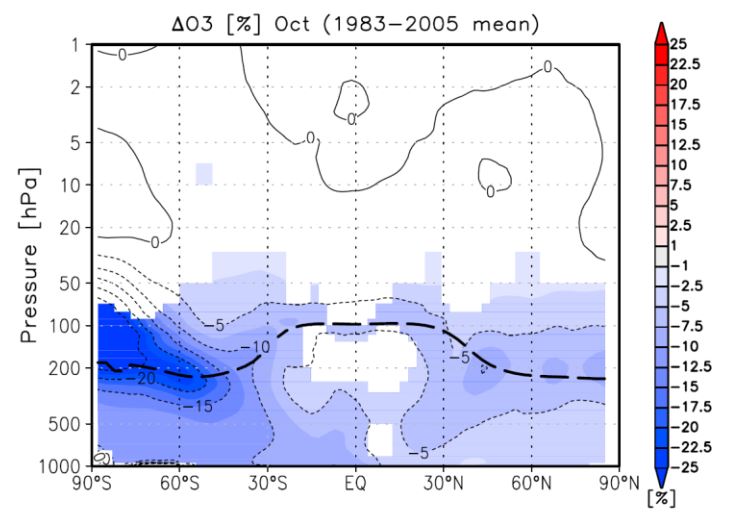← back to Scientific Themes
Impact of the Antarctic vortex on the SH-UTLS
During the winter and spring season, subsidence of polar vortex air into the Southern Hemisphere UTLS will impact the chemical composition and distribution of key radiatively active gases in this region. Ozone is strongly depleted in the Antarctic ozone hole by halogen catalyzed reactions; water vapour is significantly reduced due to dehydration by sedimentation of polar stratospheric ice particles (Solomon, 1999). Sedimentation of polar stratospheric cloud particles containing HNO3 will also affect the distribution of nitrogen oxides (NOy). Analyses of HALO observations during the TACTS/ESMVal campaign by Rolf et al. (2015) have clearly demonstrated that dehydrated and ozone depleted air masses can be identified in the Southern Hemisphere UTLS region.
Current model projections of the climate impact of stratospheric ozone recovery are still uncertain, because of large uncertainties in modelled ozone changes in the upper troposphere and lower stratosphere (UTLS) region (Bekki et al., 2013). Short-lived halogen compounds of natural and anthropogenic sources have a particularly large impact on ozone in the UTLS, and a correspondingly large efficiency in affecting climate, but their contribution to SH ozone depletion is still uncertain (Hossaini et al., 2015). Quantifying the climate impact of halogen induced ozone depletion in the UTLS region under present-day conditions, including the role of short-lived halogens, will provide constraints on the corresponding positive radiative forcing of ozone recovery during the 21st century. Recent chemistry climate modelling studies have now started to include VSLS and concluded that this significantly increases modelled stratospheric ozone depletion, with the absolute amount of ozone depletion and long-term trends in better agreement with observed losses and trends. Fernandez et al. (2017) show that inclusion of VSLS led to a modelled ozone mass deficit in the Antarctic Ozone Hole that is almost twice as large as without short-lived halogens. Sinnhuber and Meul (2015) show (see Fig. CHEM1-1) that the impact of brominated VSLS is largest in the UTLS region, with the largest contribution in the Southern Hemisphere mid- to high latitude UTLS at the bottom of the Antarctic Ozone Hole. Observations from HALO during the SouthTRAC campaign can provide important constraints on the role of shortlived halogens for ozone in the data sparse Southern Hemisphere UTLS region.

Scientific theme CHEM 1 aims to determine the distribution of halogenated VSLS in the SH-UTLS as well as the halogen induced ozone depletion in the SH-UTLS. Further, we will investigate how UTLS water vapour affected by subsidence of vortex air (see also scientific objectives).
References
Bekki, S., A. Rap, V. Poulain, S. Dhomse, M. Marchand, F. Lefevre, P. M. Forster, S. Szopa, and M. P. Chipperfield (2013). “Climate impact of stratospheric ozone recovery”. In: Geophys. Res. Lett. 40.11, pp. 2796–2800. DOI: 10.1002/grl.50358.
Fernandez, Rafael P., Douglas E. Kinnison, Jean-Francois Lamarque, Simone Tilmes, and Alfonso Saiz-Lopez (2017). “Impact of biogenic very short-lived bromine on the Antarctic ozone hole during the 21st century”. In: Atmos. Chem. Phys. 17.3, pp. 1673–1688. DOI: 10.5194/acp-17-1673-2017.
Hossaini, R., M. P. Chipperfield, S. A. Montzka, A. Rap, S. Dhomse, and W. Feng (2015). “Efficiency of short-lived halogens at influencing climate through depletion of stratospheric ozone”. In: Nat. Geosci. 8.3, pp. 186–190. DOI: 10.1038/ngeo2363.
Lörks, Dominique, et al. (in preparation, 2019). “The 2008 to 2015 trend in total stratospheric bromine inferred from airborne measurements of organic and inorganic bromine species in the polar lower stratospheres”. In: Atmos. Chem. Phys. Discuss.
Rolf, C., A. Afchine, H. Bozem, B. Buchholz, V. Ebert, T. Guggenmoser, P. Hoor, P. Konopka, E. Kretschmer, S. Müller, H. Schlager, N. Spelten, O. Sumin´ska-Ebersoldt, J. Ungermann, A. Zahn, and M. Krämer (2015). “Transport of Antarctic stratospheric strongly dehydrated air into the troposphere observed during the HALO-ESMVal campaign 2012”. In: Atmos. Chem. Phys. 15.16, pp. 9143–9158. DOI: 10.5194/acp-15-9143-2015.
Sinnhuber, Björn-Martin and Stefanie Meul (2015). “Simulating the impact of emissions of brominated very short lived substances on past stratospheric ozone trends”. In: Geophys. Res. Lett. 42.7, pp. 2449–2456. DOI: 10.1002/2014gl062975.
Solomon, Susan (1999). “Stratospheric ozone depletion: A review of concepts and history”. In: Rev. Geophys. 37.3, pp. 275–316. DOI: 10.1029/1999rg900008.
